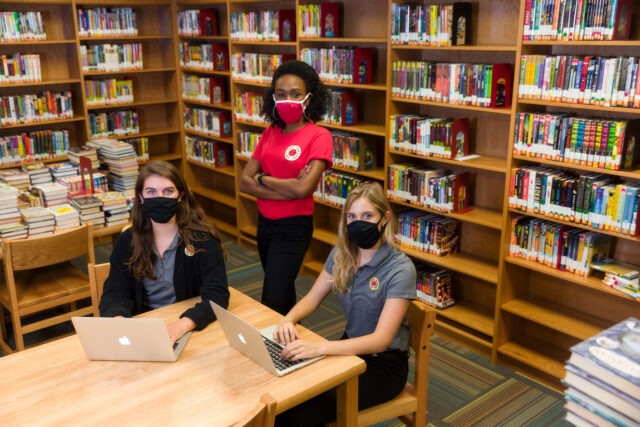Student success coaches can help students graduate
For the 15th year in a row, the high school graduation rate in the United States has increased, and once again, this growth is largely driven by Black and Latinx students and students who live in lower-income households, according to a new Grad Nation report. Based on data from 2019—the year before COVID-19 hit our schools—the national average hit a high of 85.8%.
This is encouraging news, worth celebrating. Yet, we’re not on track to reach a national high school graduation goal of 90% by 2020 and unacceptable gaps remain among groups of students. These issues make the work of City Year and our partners all the more critical as we commit to expanding educational equity and helping students recover from the disruptions, loss and stress caused by the pandemic.

In 2019:
- Latinx students’ graduation rate reached 81.7%
- Students growing up in lower-income households had a graduation rate of 80%.
- Black students’ graduation rate was 79.6%
- Students learning English had a graduation rate of 69.2%
- Students with learning differences had a graduation rate of 68.2%
- Students experiencing homelessness had a graduation rate of 67.7%
Student success coaches can help to close educational equity gaps
Building a Grad Nation: Progress and Challenges in Raising High School Graduation Rates highlights several policy recommendations that states can take to help boost graduation rates and meet the intensified needs of students and schools.
One recommendation calls for establishing a Student Success Corps that would add critical capacity to systemically under-resourced public schools like the ones served by City Year AmeriCorps members. These include high schools that have low graduation rates (67% or lower). The proposed Student Success Corps includes infusing these schools with trained “student success coaches” who nurture positive, consistent and caring relationships with students and offer academic, social and emotional supports throughout the school day and during afterschool enrichment programs.
Data shows that a small sub-set of school districts—4%—account for half of the students who do not graduate from high school. This concentration means states have an opportunity to see if “working with a small set of districts will have an outsized impact on raising college and career ready high school graduation rates, or if a broader state strategy is needed,” according to the Grad Nation report.
Longstanding and systemic educational inequities have received increased exposure during the pandemic. They underscore an urgent need to re-engage students in their learning, help them to reconnect to their school community, and provide the relationships and resources students need to graduate from high school, prepared for college and career.
Why do schools need a Student Success Corps?
A Student Success Corps could provide “the right supports to the right students in the right places, at the required scale and intensity,” the report recommends, and would be tailored to help meet local needs and goals. Evidence-based supports would include academic tutors; student success coaches like City Year AmeriCorps members, who serve as near-peer tutors, mentors and role models; postsecondary transition coaches; wraparound support site coordinators; and high-quality mentors.
We know that the holistic services provided by City Year work. A 2020 study found that the more time a student spends with a City Year AmeriCorps member, the better the student does, academically, socially and emotionally, and in terms of attendance. Research about the way children learn and develop also validates a whole-child approach, finding that students require trusting relationships, a safe and engaging learning environment, and social-emotional skill-building to thrive academically and achieve positive long-term outcomes.
We want more Black, Brown and lower-income students to have access to student success coaches and the other resources provided by the Student Success Corps, even if they never have City Year in their own school. Additional funding in public education and AmeriCorps can help realize this goal.
The crisis caused by the pandemic offers states, policymakers and education leaders a powerful opportunity to increase strategic, proven investments in schools. We believe that providing more systemically under-resourced schools with access to student success coaches—like City Year AmeriCorps members—is a key component to ensuring our students succeed, both in and out of school.
Interested in serving with City Year? Apply now:
Related stories
Yes, the holiday season can be stressful—making travel plans, wrapping up work before winter break, figuring out what gifts to...
Read more about Three reasons students may be thankful for their student success coachEvery year, thousands of young people decide to join AmeriCorps programs for a year (or more!) of service, helping to...
Read more about Everything you need to know about returning for another year as a City Year AmeriCorps memberCity Year is committed to providing our AmeriCorps members with resources, opportunities and support that help them to achieve their...
Read more about Empowering Futures: City Year Baton Rouge’s Partnership with Bottom LineFatimah Abdulmateen takes service seriously. Fatimah served two years with City Year as an AmeriCorps member, making her an alum...
Read more about A City Year alum with a passion for service—both here and abroad















